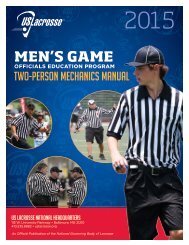BASKETBALL
You also want an ePaper? Increase the reach of your titles
YUMPU automatically turns print PDFs into web optimized ePapers that Google loves.
Rule 4 / Definitions49<br />
f. Simultaneous technical foul. A simultaneous technical foul occurs when<br />
there is a technical foul committed by each team, at approximately the<br />
same time, but not by opponents against each other.<br />
Art. 4. False double foul. A false double foul occurs when there are fouls by<br />
both teams, the second of which occurs before the game clock is started after it<br />
is stopped for the first.<br />
Art. 5. Multiple foul. A multiple foul occurs when two or more teammates<br />
commit personal fouls against the same opponent at approximately the same time.<br />
Art. 6. False multiple foul. A false multiple foul occurs when there are two or<br />
more fouls by the same team such that the last foul is committed before the game<br />
clock is started after it is stopped for the first, and such that at least one of the<br />
attributes of a multiple foul is absent.<br />
Section 16. Fumble<br />
Art. 1. A fumble shall be the accidental loss of player control when the ball<br />
unintentionally drops or slips from a player’s grasp.<br />
Art. 2. A fumble may be legally recovered by any player.<br />
Section 17. Guarding<br />
Art. 1. Guarding is the act of legally placing the body in the path of an offensive<br />
opponent. The guarding position shall be initially established and then maintained<br />
inbounds on the playing court.<br />
Art. 2. There is no minimum distance required between the guard and opponent,<br />
but the maximum distance to be considered closely guarded is 6 feet. This<br />
distance shall be measured from the forward foot or feet of the defender to the<br />
forward foot or feet of the opponent. These distances shall apply only when a<br />
player in the front court is holding the ball or dribbling.<br />
Art. 3. Every player shall be entitled to a spot on the playing court, provided that<br />
such player gets there first without illegally contacting an opponent. (Exception:<br />
Rule 4-17.7)<br />
Art. 4. To establish an initial legal guarding position on the player with the ball:<br />
a. The guard shall have both feet touching the playing court. When the guard<br />
jumps into position initially, both feet must return to the playing court after<br />
the jump, for the guard to attain a legal guarding position.<br />
b. The guard’s torso shall face the opponent.<br />
c. No time and distance shall be required.<br />
d. When the opponent with the ball is airborne, the guard shall have attained<br />
legal guarding position before the opponent begins his upward motion<br />
with his hands/arms to shoot or pass. (Exception: Rule 4-17.7)<br />
Art. 5. To establish legal guarding position on a player without the ball:<br />
a. Time and distance shall be required to attain an initial legal guarding<br />
position;<br />
b. The guard shall give the opponent the time and distance to avoid contact;<br />
c. The distance given by the opponent of the player without the ball need not<br />
be more than two strides; and<br />
d. When the opponent is airborne, the guard shall have attained legal<br />
guarding position before the opponent left the playing court.




